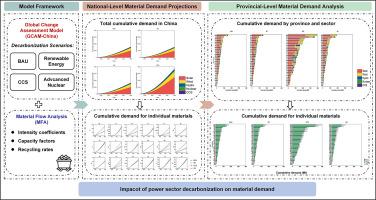关键材料与区域不平等:中国电力行业不同脱碳路径下的材料需求
IF 10.9
1区 环境科学与生态学
Q1 ENGINEERING, ENVIRONMENTAL
引用次数: 0
摘要
中国电力行业的脱碳对全球气候目标至关重要。然而,由于资源禀赋、经济发展和政策支持等方面的差异,各地区在脱碳途径和物质需求上存在差异。本研究开发了一个综合评估模型,以评估四种情景下中国电力部门脱碳的关键材料需求:照常经营(BAU)、可再生能源(RE)、碳捕集与封存(CCS)和先进核能(an)。结果显示出显著的省份差异,东部省份青睐风能和太阳能,而西部和依赖煤炭的地区则依赖水电或CCS。在全国范围内,到2060年,CCS情景中的材料需求将达到峰值,特别是铜(22.5亿吨)和镍(4.45亿吨)等结构材料。在光伏驱动的转型下,硅和铟等功能材料的需求显著增加,到2060年,可再生能源情景下,硅和铟的需求将分别达到9300万吨和1420万吨。这些发现突出表明,为实现可持续的能源转型,需要制定针对具体地区的政策、制定长期材料供应规划,并解决材料需求失衡问题。本文章由计算机程序翻译,如有差异,请以英文原文为准。

Critical material and regional inequality: Material demand under diverging decarbonization pathways in China’s power sector
China's power sector decarbonization is crucial for global climate goals. However, regional disparities in decarbonization pathways and material demands arise due to differences in resource endowment, economic development, and policy support. This study develops an integrated assessment model to evaluate critical material demand for decarbonizing China's power sector under four scenarios: Business-as-Usual (BAU), Renewable Energy (RE), Carbon Capture and Storage (CCS), and Advanced Nuclear (AN). The results show significant provincial variations, with eastern provinces favoring wind and solar, while western and coal-dependent regions rely on hydropower or CCS. Nationally, material demand peaks in the CCS scenario by 2060, especially for structural materials like copper (2250 Mt) and nickel (445 Mt). Functional materials such as silicon and indium see significant demand increases under PV-driven transitions, with silicon reaching 9300 kt and indium 14.2 Mt by 2060 in the RE scenario. These findings highlight the need for region-specific policies, long-term material supply planning, and addressing material demand imbalances for a sustainable energy transition.
求助全文
通过发布文献求助,成功后即可免费获取论文全文。
去求助
来源期刊

Resources Conservation and Recycling
环境科学-工程:环境
CiteScore
22.90
自引率
6.10%
发文量
625
审稿时长
23 days
期刊介绍:
The journal Resources, Conservation & Recycling welcomes contributions from research, which consider sustainable management and conservation of resources. The journal prioritizes understanding the transformation processes crucial for transitioning toward more sustainable production and consumption systems. It highlights technological, economic, institutional, and policy aspects related to specific resource management practices such as conservation, recycling, and resource substitution, as well as broader strategies like improving resource productivity and restructuring production and consumption patterns.
Contributions may address regional, national, or international scales and can range from individual resources or technologies to entire sectors or systems. Authors are encouraged to explore scientific and methodological issues alongside practical, environmental, and economic implications. However, manuscripts focusing solely on laboratory experiments without discussing their broader implications will not be considered for publication in the journal.
 求助内容:
求助内容: 应助结果提醒方式:
应助结果提醒方式:


